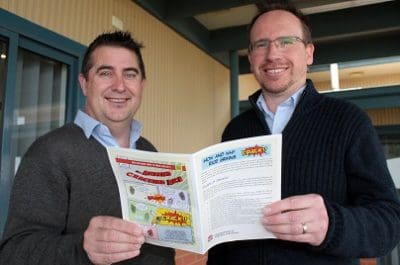AN innovative image analysis system developed by NSW Department of Primary Industries (DPI) scientists has given the rice industry an accurate and time-saving procedure to identify grain suitable for sushi and popular puffed rice products, including breakfast cereals.

NSW Department of Primary Industries researcher, Dr Mark Talbot (right) discussing scientific advances in detecting cracks in rice to identify grain suitable for sushi and puffed rice products with Dr Chris Blanchard from the Functional Grains Centre in Wagga Wagga.
NSW DPI researcher, Mark Talbot, said the automated system detected the potential of rice to crack during cooking, speeding up the process and saving labour to deliver high quality grain.
“Heavily cracked rice will turn into mush during the cooking process for sushi and puffed rice, so it’s very important the industry identifies the potential for rice to crack before grain goes to market,” Dr Talbot said.
“Now in use at SunRice, the technology has replaced manual assessment to help to keep consumers happy and protect premiums for growers.
“Rice which cracks during the milling process is downgraded, with producers receiving higher payments for grain with low cracking percentages.
“In the past, cracked grain was assessed by eye – clearly a painstaking and subjective test for thousands of rice grains.
“Automated image analysis allows thousands of grains to be analysed in minutes, instead of hours by eye, reducing human error and labour and a boon for industry and consumers.”
Measuring cracks in soaked rice was recently identified as a good indicator of cooking quality.
Known as the Hanasaki test, rice is soaked for 60 minutes before processing through the automated crack detection and counting system to determine cracking percentages.
NSW DPI scientists based at the Yanco Agricultural Institute are working closely with SunRice to fine-tune the system as a quality test for the rice industry.
Source: NSW DPI



HAVE YOUR SAY